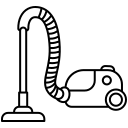The Ultimate Cleaning Process for Homeowners: A Comprehensive Guide

Introduction to Effective Home Cleaning
A structured cleaning process is essential for homeowners aiming to maintain a pristine living environment. A clean home offers numerous benefits, including improved mental health, reduced allergens, and a more inviting space for both residents and visitors. The psychological impact of cleanliness should not be underestimated; a tidy home can significantly alleviate stress and anxiety, fostering a sense of order and control.
Furthermore, regular cleaning plays a crucial role in minimizing allergen exposure. Dust, pet dander, and mold are common irritants that can exacerbate allergies and respiratory conditions. By adhering to a consistent cleaning regimen, homeowners can create a healthier atmosphere, reducing the potential for allergic reactions and enhancing overall well-being.
In addition to health benefits, a well-maintained home is inherently more welcoming. Whether hosting guests or simply enjoying personal time, a clean environment contributes to a positive and comfortable experience. A clutter-free space allows for better organization and easier access to belongings, making daily tasks more manageable and less time-consuming.
Despite these advantages, many homeowners encounter challenges in maintaining cleanliness. Common obstacles include time constraints, lack of motivation, and uncertainty about effective cleaning techniques. These challenges can lead to sporadic cleaning efforts, resulting in accumulated dirt and clutter. However, a well-defined cleaning process can address these issues by providing a clear framework and actionable steps.
Implementing a structured cleaning routine helps in breaking down tasks into manageable segments, making it easier to stay on top of household chores. This systematic approach ensures that no area is neglected and that cleaning becomes a habitual part of daily life rather than an overwhelming burden. By understanding the importance of a structured cleaning process, homeowners can transform their living spaces into healthier, happier, and more inviting environments.
Preparing for Cleaning: Tools and Supplies
Embarking on a comprehensive home cleaning process necessitates the right tools and supplies. These essentials are the backbone of an efficient and effective cleaning routine. To start, basic items such as sponges, microfiber cloths, and vacuum cleaners are indispensable. Sponges are versatile tools that can handle a variety of surfaces, while microfiber cloths are known for their superior ability to trap dust and dirt without leaving streaks. A high-quality vacuum cleaner, equipped with various attachments, ensures that all types of flooring and upholstery are thoroughly cleaned.
In addition to these basics, specific cleaners tailored to different surfaces play a crucial role in achieving optimal cleanliness. For instance, glass cleaners are formulated to prevent streaks on windows and mirrors, whereas wood cleaners and polishes preserve the integrity and shine of wooden surfaces. Bathroom cleaners, on the other hand, are designed to tackle soap scum, mildew, and hard water stains effectively.
For homeowners concerned about the environment and the health of their family, eco-friendly and non-toxic cleaning alternatives are available. These products, often made from natural ingredients such as vinegar, baking soda, and essential oils, are not only effective but also reduce the exposure to harsh chemicals. Using eco-friendly options can significantly diminish the risk of respiratory problems and skin irritations, making them a safer choice for households with children and pets.
Safety is paramount in the cleaning process. It is advisable to wear gloves to protect the skin from potential allergens and irritants found in cleaning products. Adequate ventilation is also important to prevent the inhalation of fumes. Homeowners should always read and follow the instructions on cleaning product labels to ensure proper use and avoid any hazards.
In summary, preparing for cleaning requires a thoughtful selection of tools and supplies. By opting for the right equipment and considering eco-friendly alternatives, homeowners can achieve a spotless home while safeguarding their family’s health and the environment.
Creating a Cleaning Schedule
Establishing a cleaning schedule is crucial for maintaining a well-organized and hygienic home. A structured plan ensures that no area is neglected, making it easier to keep your living space in pristine condition. To begin, break down your cleaning tasks into daily, weekly, and monthly chores, which will help manage the workload effectively and prevent overwhelming yourself.
Daily tasks should include quick and essential activities such as wiping down kitchen counters, doing the dishes, and making the beds. These chores are crucial for maintaining a baseline of cleanliness and preventing clutter from accumulating. Weekly tasks can be more extensive, such as vacuuming carpets, mopping floors, and cleaning bathrooms. These activities address areas that require regular but not daily attention, ensuring they remain clean and sanitary.
Monthly chores often involve deep cleaning tasks that go beyond the surface. This can include cleaning windows, dusting ceiling fans, and decluttering storage areas. Addressing these tasks on a monthly basis helps maintain a high standard of cleanliness and prevents dirt and grime from building up over time.
Tailoring your cleaning schedule to fit your household size and lifestyle is also essential. For larger families, it might be beneficial to delegate specific tasks to different family members to share the workload. Smaller households might find it easier to manage with a more streamlined schedule. Consider your daily routines and peak activity times to optimize your cleaning efforts efficiently.
Maintaining flexibility within your schedule is key. Life can be unpredictable, and it’s important to allow for adjustments as needed. Regularly review and tweak your schedule to ensure it remains realistic and manageable. By integrating these strategies, homeowners can create a comprehensive cleaning process that keeps their homes clean and well-maintained year-round.
Room-by-Room Cleaning Guide
Cleaning your home can be a daunting task, but taking it one room at a time can make the process more manageable and effective. Here is a detailed guide to help you clean each room thoroughly, ensuring that every corner of your home is spotless and inviting.
Living Room
Start by decluttering the living room, removing any items that do not belong. Dust all surfaces, including shelves, picture frames, and electronics. Use a microfiber cloth to avoid leaving streaks. Vacuum upholstered furniture, and pay special attention to nooks and crevices where dust and debris can accumulate. Finish by vacuuming or sweeping the floor, and mop if necessary.
Kitchen
The kitchen requires a bit more attention due to food preparation areas. Begin by clearing countertops and wiping them down with a disinfectant. Clean the stovetop, ensuring to remove any burnt-on food stains. Wipe down appliances like the refrigerator, microwave, and dishwasher. Empty the trash and replace the liner. Sweep and mop the floor, focusing on corners and under cabinets where crumbs tend to gather.
Bathrooms
In the bathroom, start by removing any items from the counters and shelves. Clean the sink, faucet, and countertops with a bathroom cleaner. Scrub the toilet inside and out, including the base and handle. Clean the shower or bathtub, paying attention to grout and glass doors. Wipe down mirrors with glass cleaner to avoid streaks. Finally, sweep and mop the floor to remove any hair or dust.
Bedrooms
Begin by making the bed and organizing any clutter on nightstands or dressers. Dust all surfaces, including lamps and picture frames. Vacuum or sweep the floor, and if you have carpets, consider using a carpet cleaner for a deeper clean. Don’t forget to vacuum under the bed and in the closet. Finish by wiping down mirrors and windows to ensure a clear, streak-free shine.
Additional Spaces
For additional spaces like home offices or laundry rooms, start by organizing and decluttering the area. In the home office, dust surfaces, including electronics, and vacuum the floor. In the laundry room, wipe down the washer and dryer, and clean any lint traps. Sweep and mop the floor, and ensure all cleaning supplies are neatly stored.
By following this room-by-room guide, you can ensure that every part of your home is clean and well-maintained. Taking the time to clean each room thoroughly will not only make your home look better but also create a healthier living environment for you and your family.
Deep Cleaning Tips and Tricks
Deep cleaning is an essential part of maintaining a truly clean and healthy home environment. Unlike regular cleaning tasks, deep cleaning involves a more thorough approach, targeting areas that are often overlooked during routine cleaning. This section will provide you with valuable tips and tricks for tackling these comprehensive tasks, ensuring that your home remains pristine.
One of the most critical deep cleaning tasks is cleaning behind appliances. Dust, grease, and grime can accumulate behind your refrigerator, stove, and other large appliances. It is recommended to move these appliances at least twice a year to clean the areas behind and underneath them. Utilize a vacuum with a crevice tool attachment to remove dust and debris, followed by a damp cloth to wipe down surfaces.
Washing windows is another task that can significantly enhance the appearance of your home. For sparkling clean windows, use a mixture of equal parts water and white vinegar in a spray bottle. Spray the solution onto the windows and wipe with a microfiber cloth or a squeegee. This method not only removes dirt and streaks but also prevents the buildup of grime over time. It is advisable to clean your windows at least twice a year, ideally in the spring and fall.
Carpet cleaning is essential for removing deep-seated dirt, allergens, and stains. While vacuuming is effective for surface dirt, professional carpet cleaning or renting a steam cleaner can provide a more thorough clean. Aim to deep clean your carpets every 12 to 18 months, depending on foot traffic and the presence of pets or children. Spot treat stains promptly to prevent them from setting in.
Descaling bathroom fixtures is crucial to prevent limescale buildup, which can damage your fixtures and reduce water flow. Use a descaling solution or a mixture of white vinegar and water to remove limescale from showerheads, faucets, and other fixtures. Soak removable parts in the solution for an hour, then scrub with a brush and rinse thoroughly. Perform this task every three to six months to maintain optimal performance and appearance.
By incorporating these deep cleaning tips and tricks into your regular cleaning routine, you can ensure that your home remains not only clean but also well-maintained. Periodic deep cleaning is key to a healthier, more pleasant living environment.
Organizing and Decluttering
Effective cleaning isn’t solely reliant on scrubbing and dusting; it also encompasses the critical aspect of organization. A well-organized space not only enhances the aesthetic appeal of your home but also facilitates easier cleaning in the future. The first step in the organizing process is decluttering, which involves sorting through your possessions and determining which items are essential. Begin by categorizing your belongings into three groups: keep, donate, and discard. This method ensures that you retain only what is necessary, thereby reducing clutter.
Once you have sorted your items, the next step is to implement efficient storage solutions. Utilize various storage options such as shelves, bins, and baskets to keep your items organized. For instance, clear plastic bins are excellent for storing seasonal clothing, while labeled baskets can help manage everyday items like toiletries and office supplies. Additionally, investing in multi-functional furniture, such as ottomans with storage compartments, can further aid in maintaining an organized space.
Maintaining an organized home is an ongoing process that requires consistent effort. Establishing daily habits can significantly contribute to sustaining order. Simple practices such as putting items back in their designated places after use, conducting regular reviews of your possessions, and tidying up at the end of each day can prevent clutter from accumulating. Moreover, adopting a minimalist approach by limiting the acquisition of new items can help maintain a clean and organized home. A clutter-free environment not only simplifies the cleaning process but also promotes a sense of tranquility and well-being.
Maintaining a Clean Home
Once the home is thoroughly cleaned, maintaining that level of cleanliness becomes essential. Daily habits and routines play a crucial role in ensuring that homeowners can enjoy a consistently clean living environment. Implementing a few simple actions can make a significant difference in keeping the home tidy and well-organized.
One of the most effective ways to maintain cleanliness is by developing a habit of wiping down surfaces regularly. Kitchen counters, bathroom sinks, and other frequently used areas can quickly accumulate dirt and grime. By taking a few moments each day to clean these surfaces, homeowners can prevent the buildup of debris and maintain a polished appearance.
Another key practice is putting things away immediately after use. Whether it’s returning books to the shelf, placing dishes in the dishwasher, or hanging up clothes, tidying up as you go prevents clutter from accumulating. This habit not only keeps the home looking neat but also makes it easier to find items when needed.
Spot-cleaning spills as soon as they occur is also vital in maintaining a clean home. Addressing spills and stains promptly prevents them from setting in and becoming more difficult to remove later. A quick response to spills can preserve the condition of surfaces and fabrics, ensuring that they remain in good shape over time.
Incorporating these daily routines into a homeowner’s lifestyle can significantly contribute to maintaining a clean and orderly home. By consistently wiping down surfaces, putting things away immediately, and spot-cleaning spills, homeowners can enjoy a pristine living environment with minimal effort. These small, manageable actions can collectively make a substantial impact on the overall cleanliness of the home.
Conclusion and Final Tips
In conclusion, maintaining a clean and organized home is essential for fostering a healthy and stress-free living environment. Throughout this guide, we have explored various aspects of the ultimate cleaning process for homeowners, from creating a detailed cleaning schedule to utilizing effective cleaning tools and products. Consistency is the cornerstone of any successful cleaning routine, as regular upkeep prevents the accumulation of dirt and clutter, making the overall process more manageable.
One key takeaway is the importance of breaking down cleaning tasks into smaller, more manageable segments. This approach not only makes the process less overwhelming but also ensures that each area of the home receives the attention it needs. Homeowners should prioritize high-traffic areas and frequently used items, such as kitchens and bathrooms, to maintain hygiene and orderliness.
Additionally, investing in quality cleaning tools and eco-friendly products can significantly enhance the efficiency and safety of your cleaning efforts. Microfiber cloths, vacuum cleaners with HEPA filters, and non-toxic cleaners are just a few examples of items that can make a noticeable difference in your cleaning routine. Moreover, involving all household members in the cleaning process can foster a sense of shared responsibility and teamwork.
It is also worth noting that a clean home contributes to overall well-being. A tidy living space can reduce stress, improve mental clarity, and even promote better physical health by minimizing allergens and pathogens. Therefore, the time and effort invested in maintaining a pristine home are well worth the benefits.
We encourage you to share your own tips and experiences in the comments section below. By exchanging ideas and strategies, we can create a community of cleanliness enthusiasts who support and inspire one another in the pursuit of a spotless and harmonious home.











 Home
Home  Book Now
Book Now  Call Us
Call Us  Whatsapp
Whatsapp  Login
Login